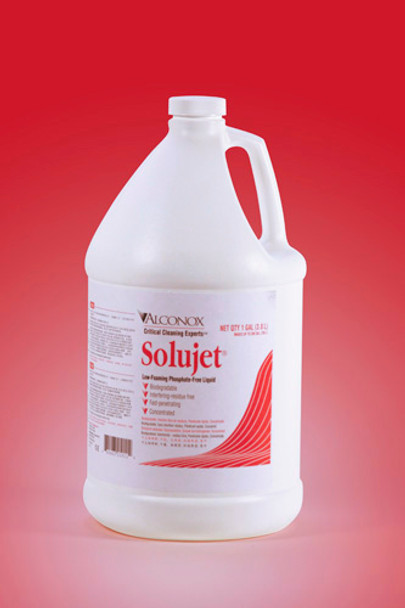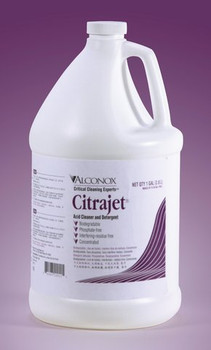Description
Solujet detergent, low foaming, phosphate-free liquid (4X3.8 L)
PROPERTIES
packaging
pkg of 3.8 L
manufacturer/tradename
Alconox, Inc. 2101
General description
Solujet low-foaming phosphate-free liquid detergent
Used to clean: Pharmaceutical process equipment, water testing labware, phosphate sensitive lab equipment cleaning, hospital instruments, optical components, pharmaceutical apparatus, cosmetics manufacturing equipment, tissue culture ware, plate glass, metal castings, forgings and stampings, industrial parts, animal cages, electronic components, tanks and reactors. USDA authorized category A1 for use in food contact surface cleaning. FDA certified.
Used to remove: Soil, radioisotopes, radioactivity, organics, grit, grime, slime, grease, tars, resins, fats, oils, blood, tissue, particulates, inorganic residues, chemical and solvents.
Surfaces cleaned: Recommended for glass, stainless steel, PTFE, ceramic, cement and alkali resistant plastics and metals such as stainless steel. Solujet is inhibited for Aluminum. Corrosion testing is advisable.
Clean-in place, laboratory warewashers, dishwashers, cart washers, spray washers, electrocleaning, ultrasonic cleaners, and manual cleaning if proper skin and eye protection is used
Directions: Follow machine manufacturers directions. Not intended for powder detergent receptacles. If available, use liquid detergent reservoir, connecting tubes or metering pump. In general, use 1/2 - 1% solution in hot water wash cycle (1 1/4 - 2 1/2 Tbsp. per gal., 3/4 - 1 1/4 oz. per gal. or 5-10 ml per liter--most machines need 2 1/2 oz. added at a typical 2 gal. wash cycle). For soak, circulate or ultrasonic use, make a 1% solution in cold, warm or hot water.
For difficult soils, raise water temperature and use more detergent. Wear protective gloves and eyewear when handling.
RINSE THOROUGHLY preferably with running water. For critical cleaning, do final or all rinsing in distilled, deionized or purified water. For food contact surfaces, rinse with potable water.
- Concentrated to save you money
- Phosphate-free, biodegradable and readily disposable
- Low foaming high wetting detergent for maximum per formance
- Free rinsing to give you reliable results and no interfering residues
- Ideal for CIP cleaning and floor standing lab washing machines
Used to clean: Pharmaceutical process equipment, water testing labware, phosphate sensitive lab equipment cleaning, hospital instruments, optical components, pharmaceutical apparatus, cosmetics manufacturing equipment, tissue culture ware, plate glass, metal castings, forgings and stampings, industrial parts, animal cages, electronic components, tanks and reactors. USDA authorized category A1 for use in food contact surface cleaning. FDA certified.
Used to remove: Soil, radioisotopes, radioactivity, organics, grit, grime, slime, grease, tars, resins, fats, oils, blood, tissue, particulates, inorganic residues, chemical and solvents.
Surfaces cleaned: Recommended for glass, stainless steel, PTFE, ceramic, cement and alkali resistant plastics and metals such as stainless steel. Solujet is inhibited for Aluminum. Corrosion testing is advisable.
Clean-in place, laboratory warewashers, dishwashers, cart washers, spray washers, electrocleaning, ultrasonic cleaners, and manual cleaning if proper skin and eye protection is used
Directions: Follow machine manufacturers directions. Not intended for powder detergent receptacles. If available, use liquid detergent reservoir, connecting tubes or metering pump. In general, use 1/2 - 1% solution in hot water wash cycle (1 1/4 - 2 1/2 Tbsp. per gal., 3/4 - 1 1/4 oz. per gal. or 5-10 ml per liter--most machines need 2 1/2 oz. added at a typical 2 gal. wash cycle). For soak, circulate or ultrasonic use, make a 1% solution in cold, warm or hot water.
For difficult soils, raise water temperature and use more detergent. Wear protective gloves and eyewear when handling.
RINSE THOROUGHLY preferably with running water. For critical cleaning, do final or all rinsing in distilled, deionized or purified water. For food contact surfaces, rinse with potable water.





